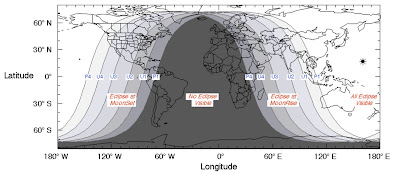To start, a lunar eclipse is the opposite of a solar eclipse. Where a solar eclipse is the Moon blocking sunlight from reaching Earth, a lunar eclipse is the Earth blocking sunlight from reaching the Moon. Given the Earth is a much bigger object, the shadow Earth casts onto the Moon during a lunar eclipse is much larger. Therefore, you do not need to be as localized on Earth to view a total lunar eclipse. If you are basically on the side of Earth facing the Moon at the time of a total lunar eclipse, you will see the total lunar eclipse. Although not as impressive, in my opinion, as total solar eclipses, total lunar eclipses are still a sight to see!
The next total lunar eclipse is January 31, 2018. This eclipse is observable from most of Asia, Australia, Alaska, Hawaii, and maybe just a bit of the very western continental U.S., as shown in the map below.
The white areas in the map will see totality. As you can see, about half of the world will see the eclipse and the other half will not. Some parts will see a partial eclipse. The next total lunar eclipse observable from the continental U.S. is the next year, on January 21, 2019. On this day, the entire continental U.S. will see a total lunar eclipse.
Lunar eclipses, although not as impressive as a solar eclipse, are still impressive and the U.S. population has the opportunity to see a total lunar eclipse in less than two years!


No comments:
Post a Comment